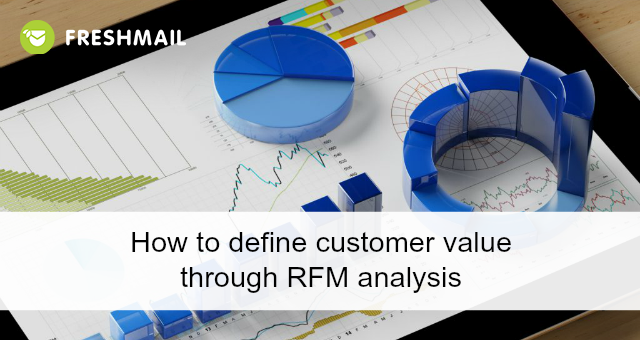 Paweł Sala
created
edited
Paweł Sala
created
edited
How to define customer value through RFM analysis
Back to list of articlesAnyone who works in sales knows that you often have to deal with requests for discounts, special deals or other incentives to close the sale. This is particularly common among regular customers who think about reducing the price of something they know they will continue to buy well into the future.
Most businesses are ready for these situations and often base their reply to demands for a lower price on the idea of “the more they’ve bought up until now, the greater discount we can offer”.

But there’s another, more precise way to handle your pricing relationship with long-term customers that applies to just about every kind of business. I’m referring to RFM analysis and to a specific application of it in particular.
Find out how to define customer value through RFM analysis.
What is RFM analysis?
It’s a concept promoted by Jim Novo in his book “ Drilling Down” and uses three factors to evaluate the value of a customer:
- recency - how much time has passed since a customer’s last purchase,
- frequency - how often does the customer interact with you or make a purchase,
- monetary - how much has a particular customer spent with you.
All of your customers, potential customers and, if applied to email marketing - subscribers, can be measured according to the principles of RFM analysis. The shorter the time since a customer’s last purchase, the more valuable that customer is. A customer who buys more often is even more valuable and the more he spends, the more his value increases even more. RFM analysis creates a matrix in which each field is filled with a 3 number’s score from one to three.
Using RFM analysis lets you easily evaluate the value of specific customers, which in turn informs who you target with marketing campaigns. Customers who’ve made a purchase recently don’t need to be “woken up” and resources can be directed towards engaging other customers that you haven’t heard from in a while. If it seems complicated, there’s a simple way to implement it and develop a discount policy that works for your business.
Time Since Last Purchase - Recency
In the approach I’m recommending, I want you to focus only on the Recency metric. And instead of counting only purchases, expand the range to include interactions with your brand or site. This method works much better for online businesses and gives a more accurate measure of potential customer interest.
For the purposes of this article, I’m going to make a slight change to the standard RFM analysis by adding something that I use when advising FreshMail clients. It’s about using time periods to better identify customers who are more active and engaged. I use the divisions that are:
- 0 - 30 days since last purchase or interaction (segment 1)
- 31- 60 days since last purchase or interaction (segment 2)
- 61- 90 days since last purchase or interaction (segment 3)
- more than 90 days since last purchase or interaction (segment 4)
Start your own RFM analysis by segmenting your customers into separate groups. Theoretically, those in segment 1 don’t need much of a marketing message directed at them.
First of all, you don’t know how much they spent on their last purchase since you’re only looking at the date, not the value, and so there’s no point in sending a promotional offer. It could happen that you send a discount offer for something the customer already purchases regularly and only makes them angry for paying a higher price. It can also make them reluctant to make another purchase until they get a discount offer.
Secondly, these customers are probably not ready to make another purchase from you anyway so you’re better off directing your marketing elsewhere. This is an especially important issue in business that see a lot of repeat purchases - if customers are obviously happy with the current pricing, best to leave it alone.
On the other hand, customers in segment 4 need strong incentives to make a purchase with you. The only question here is how much you’re able to offer. Personally, I think the best thing to do is check the stats to see what kind of offer gets the best Response Rate.
Response Rate Indicator
To define the right Response Rate, start by running tests for each segment. Email marketing campaigns are perfect for helping to get the data you need. For segment 4, run a test like this:
- Randomly choose 10% of your customers (if you have a small list to start with, increase the percentage)
- Make 4 segments and be careful no one appears in more than one of them
- Send a price promotion to each segment - let’s say 5%, 10%, 15% and 20% off - on any purchase in the next 30 days
- After the 30 days, get the final stats on the number of purchases in the different segments and their value
- Run the numbers and see how much did you earned, what margins have you achieved on each segment and which segment was the most profitable.
You numbers might look something like this:
| Customers in segment |
1 000 |
1 000 | 1 000 | 1 000 |
| Discount given | 5% | 10% | 15% | 20% |
| Response Rate | 2% | 3% | 5% | 6% |
| Number of purchases | 20 (2% of customers) |
30 (3% of customers) |
50 (5% of customers) |
60 (6% of customers) |
| Average order value | $100 | $100 | $100 | $100 |
| Total sales | $2,000 ($100 x 20) |
$3,000
($100 x 30) |
$5,000
($100 x 50) |
$6,000
($100 x 60) |
| Profit margin | 30% | 30% | 30% | 30% |
| Profit before discount | $600
(30% x $2,000) |
$900
(30% x $3,000) |
$1,500
(30% x $5,000) |
$1,800
(30% x $6,000) |
| Cost of discount | $100
(5% * $2,000) |
$300
(10% * $3,000) |
$750
(15% * $5,000) |
$1,200
(20% * $6,000) |
| Net profit after discount | $500
($600 - $100) |
$600
($900 - $300) |
$750
($1,500 - $750) |
$600
($1,800 - $1,200) |
What conclusions can we draw from this analysis? First of all, customers respond to discount offers. Secondly, the highest sales don’t always bring the highest profits. The data from the table (which is based on results from one of our clients) says that the most profitable segment is the one that responded to a 15% discount with a 5% Response Rate.
You should run similar tests for all of your segments to learn where the sweet spot is for price promotions and their profitability for you as well as what kind of Response Rate you can expect.
What Next?
So what do you do after you know the best price promotion for your customers?
First of all, if you’re dealing with a large number of customers and you operate mostly online, you should use the information to boost your marketing. Email marketing is the perfect channel for getting your message out. You can also create segments based on how recently customers have interacted with Google Adwords campaigns. We’ll have to leave that for another article since it’s not a simple matter although it can be very profitable.
If you're running a smaller-scale promotional activities - it's always good to use the email marketing backed by direct sales. Personally, I would recommend that your sales team focus first on the persons in segment 4. The team will be able to present the offer and at the same time gather feedback on why someone has stopped using your product. Such information will allow you to build up better communication strategy.
More Than Just Customers
You can use these techniques for more than measuring customers. They can also be applied to subscribers to a newsletter or visitors to a site. This means being able personalize your message more effectively than ever before. Remember that this is just the first step in RFM analysis. I sometimes recommend an analysis of the number of purchases or interactions or amount spent but that’s a subject for another day.

